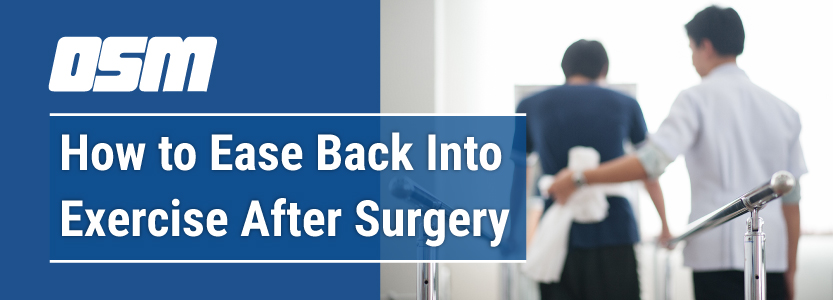How to Ease Back Into Exercise After Surgery
Article featured on MedicineNet
Patients who’ve had surgery should ease back into movement and exercise.
These efforts may be small, but they’re better than nothing, according to one surgeon who emphasized the importance of listening to your body.
“The most important thing is patient comfort. After surgery, there is often this apprehension of, ‘If I move or do something, I will hurt or damage the area where I had surgery,’” said Dr. Adil Ahmed, an assistant professor in the Department of Orthopedic Surgery at Baylor College of Medicine in Houston. “We must counsel patients pre-op and post-op, telling them what is safe to do in terms of physical activity because they should be mobile.”
Start by doing small tasks after surgery. For shoulder replacement patients in a sling and with limited mobility for four weeks, move your fingers, open and close your hands, squeeze a stress ball and flex and extend the wrist and elbow, Ahmed suggested. This can keep the joints from getting stiff and prevent swelling.
“In those first four weeks, you’re doing very gentle, rotational motions because you want everything to heal, and then you progress in therapy and remove those restrictions,” he said in a Baylor news release. “Once your motion begins to improve, you begin strengthening.”
If your arm is in a sling, just focus on getting out of bed on your own, going to the bathroom alone or putting on and taking off clothes and shoes.
After that, you can slowly start going back into physical activity, such as walking with gentle motion.
Modify your exercise routine during recovery by focusing on the areas that you can move instead of being sedentary, Ahmed advised.
After a shoulder replacement, use your free arm to hold a broomstick and move it around. Progressively start using heavier sticks to strengthen the other arm.
If it’s your wrist or elbow that’s healing, focus on working your legs and core. You can gradually start incorporating your arm workout into your routine as well, Ahmed said.
Basic workouts using resistance bands can be a good idea.
“If you can get to the gym and do something, even if it isn’t your normal routine, that’s great. Something is always better than nothing,” Ahmed said.
Controlled movements are best to minimize pain. Riding a stationary bike, for example, elevates the heart rate with low impact. This is an easy workout even if your arm is restricted in a sling. Walking is encouraged after surgery.
Start light when you do return to the gym, Ahmed recommended.
“It’s always a progression, and you never want to hit the weights right away. You should start with light bodyweight exercises, much less than you were doing before surgery, because it’s not about getting strong right away. You must do everything within the same motion parameters because the natural body response is to power through pain, which is how you injure yourself,” he said.
Use pain as your guide when beginning physical activity after surgery, Ahmed suggested.
If something hurts, that should be the upper threshold limit to you.
Avoid suffering through the pain. Gaining motion is more important during the recovery period than strengthening.
Patients often fall into two groups: overcautious, which can cause stiffness and a longer recovery, and aggressive, pushing too far too fast.
Patients with fractures that involve a joint need to use more care because the joint can shift, which may cause the patient to develop arthritis for life.
Patients should ask their surgeons a number of questions, Ahmed said. They should ask about range of motion including, “Is it safe to move or not? Are there any restrictions on movement?” They should ask about weight bearing: “Can I weight bear or not? Can I push, pull or lift items?”
They should also ask if they need to be in the sling constantly or can take it off for a certain amount of time. Also ask about therapy, including when to start and whether you should do basic home exercises.
“I try to make a point to tell patients this information, but it’s important with any type of surgery — not just the extremities — to ask these questions,” Ahmed said.
The Orthopedic & Sports Medicine Center of Oregon is an award-winning, board-certified orthopedic group located in downtown Portland Oregon. We utilize both surgical and nonsurgical means to treat musculoskeletal trauma, spine diseases, foot and ankle conditions, sports injuries, degenerative diseases, infections, tumors and congenital disorders.
Our mission is to return our patients back to pain-free mobility and full strength as quickly and painlessly as possible using both surgical and non-surgical orthopedic procedures.
Our expert physicians provide leading-edge, comprehensive care in the diagnosis and treatment of orthopedic conditions, including total joint replacement and sports medicine. We apply the latest state-of-the-art techniques in order to return our patients to their active lifestyle.
If you’re looking for compassionate, expert orthopedic and podiatric surgeons in Portland Oregon, contact OSM today.
Phone:
Address
1515 NW 18th Ave, 3rd Floor
Portland, OR 97209
Hours
Monday–Friday
8:00am – 4:30pm




